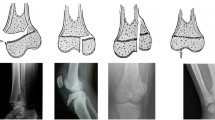Abstract
Purpose
The aim of this study was to evaluate our treatment methods of proximal humeral physeal injuries retrospectively and elucidate the relationship between the trauma mechanism, the radiographic injury pattern, the consequent therapy and the functional outcome, and to further deduct and verify prognostic criteria.
Methods
At our Department of Trauma Surgery, 303 children and adolescent patients with fractures of the proximal humeral epiphysis were treated from 1992 to 2009. 72 cases were diagnosed as physeal fractures according to the Salter–Harris classification and were included in our study.
Results
15 physeal fractures of the proximal humerus were reconstructed anatomically by open or closed reduction and produced 93.3% excellent results. 57 physeal fractures were treated in a conservative way and produced 94.7% excellent results.
Conclusion
We state that epiphyseal injuries should to be treated depending on the age of the patient. This is the only way to decrease the rate of posttraumatic epiphysiodesis with consequent problems, including limb-length discrepancy and/or angular deformities.



Similar content being viewed by others
References
Rose SH, Melton LJ 3rd, Morrey BF et al (1982) Epidemiologic features of humeral fractures. Clin Orthop Relat Res 168:24–30
Neer CS 2nd, Horwitz BS (1965) Fractures of the epiphyseal plate. Clin Orthop 41:24–30
Peterson CA, Peterson HA (1972) Analysis of the incidence of injuries to the epiphyseal growth plate. J Trauma 12:275–281
Baxter MP, Wiley JJ (1986) Fractures of the proximal humeral epiphysis. Their influence on humeral growth. J Bone Joint Surg Br 68:570–573
Dobbs MB, Luhmann SL, Gordon JE (2003) Severely displaced proximal humeral epiphysial fractures. J Pediatr Orthop 23:208–215
Schwendenwein E et al (2004) Displaced fractures of the proximal humerus in children require open/closed reduction and internal fixation. Eur J Pediatr Surg 14:51–55. doi:10.1055/s-2004-815781
Ogden JA, Humerus (2000) Skeletal injury in the child. Springer, New York, pp 456–541
Barnet LS (1985) Little league shoulder syndrome: proximal humeral epiphysiolysis in adolescent baseball pitchers. J Bone Joint Surg Am 67:495–496
Chaill BR, Tullos HS, Fain RH (1974) Little league shoulder. J Sports Med 2:150–155
Strauss RH, Lanese RR (1982) Injuries among wrestlers in school and college tournaments. JAMA 248:2016–2018
Dameron TB Jr, Reibel DB (1969) Fractures involving the proximal humeral epiphyseal plate. J Bone Joint Surg Am 51:289–297
Salter RB, Harris R (1963) Injuries involving the epiphyseal plate. J Bone Joint Surg Am 45:587–622
Von Laer L (2007) Verletzungen des Schultergürtels und des Humerusschaftes, Thieme, Frakturen und Luxationen im Wachstumsalter. Stuttgart, Germany, pp 105–110
Blount WP (1957) Knochenbrüche bei Kindern. Stuttgart, Thieme, Germany, pp 226–228
Judet J (1964) Fractures du col chirurgical de l´humerus. Acta Orthop Belg 243–248
Aitken AP (1963) The end results of the fractured distal tibial epiphysis. J Bone Joint Surg 18:685–691
Carothers CO, Crenshaw AH (1963) Clinical significance of a classification of epiphyseal injuries of the ankle. Am J Surg 89:879–889
Sferopoulos NK (2007) Type V physeal injury. J Trauma 63:121–123. doi:10.1097/01.ta.0000195443.54418.54
Rockwood CA, Wilkins KE, Beaty JH (1996) Proximal humerus fractures. Fractures in children, vol 3, 5th edn. Lippincott-Raven, Philadelphia, pp 929–952
De Sanctis N, Della Corte S, Pempinello C (2000) Distal tibial and fibular epiphyseal fractures in children: prognostic criteria and long term results in 158 patients. J Pedeatr Orthop B 9:40–44
Author information
Authors and Affiliations
Corresponding author
Rights and permissions
About this article
Cite this article
Binder, H., Schurz, M., Aldrian, S. et al. Physeal injuries of the proximal humerus: long-term results in seventy two patients. International Orthopaedics (SICOT) 35, 1497–1502 (2011). https://doi.org/10.1007/s00264-011-1277-8
Received:
Accepted:
Published:
Issue Date:
DOI: https://doi.org/10.1007/s00264-011-1277-8




